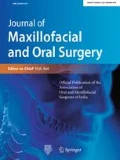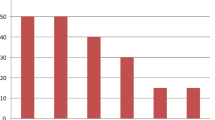Abstract
Objective
To compare the efficacy of CRP and TLC as markers for monitoring the course of odontogenic space infections (OSI) in 50 patients.
Methods
A Clinical severity scale (CSS) was developed to grade the severity of infections in patients. Blood samples were taken preoperatively and postoperatively at day 1, day 2, day 3 and day 7 for measuring the levels of CRP and TLC. The trends of CRP and TLC were analysed against the CSS. The data was subjected to paired “t” test, ANOVA, Spearman rank correlation, Pearson’s bivariate correlation as appropriate.
Results
The CRP values were elevated in all 50/50 (100 %) patients as compared to TLC which were elevated in 32/50 (64 %) patients only. The CSS displayed a high internal consistency and reliability (Cronbach α = 0.748). A significant strong positive correlation (ρ = 0.754) was found between CRP and CSS as compared to a moderate correlation (ρ = .607) between TLC and CSS.
Conclusion
CRP displayed a more consistent relation with clinical severity of the infection than TLC. Hence it could be more reliably employed to judge the progress in a patient with OSI.



Similar content being viewed by others
References
Ylyjoki S, Suuronen R, Somer HJ, Meurman JH, Lindqvist C (2001) Differences between patients with or without the need for intensive care due to severe odontogenic infections. J Oral Maxillofac Surg 59:867–872
Ren YF et al (2007) Rapid quantitative determination of C-reactive protein at chair side in dental emergency patients. J Tripleo 104(1):49–55
Sganga et al (1985) Hepatic protein repriosation after trauma and sepsis. J Surg 120:189–199
Sabel KG, Wadsworth C (1979) C-reactive protein in early diagnosis of neonatal septicemia. Acta Paediatr Scand 68:825–831
Bali R, Sharma P, Gaba S (2015) Use of metronidazole as part of an empirical antibiotic regimen after incision and drainage of infections of the odontogenic spaces. Br J Oral Maxillofac Surg 53(1):18–22. doi:10.1016/j.bjoms.2014.09.002
Bahl R, Sandhu S, Singh K, Sahai N, Gupta M (2014) Odontogenic infections: microbiology and management. Contemp Clin Dent 5(3):307–311
Knaus WA, Draper EA, Wagner DP, Zimmerman JE (1985) APACHE II: a severity of disease classification system. Crit Care Med 13(10):818–829
Póvoa P (1998) C-reactive protein as an indicator of sepsis. Intensive Care Med 24(10):1052–1056
Barreto VT, Isaac A, Bhimidi P, Nguyen C, Jones G (2013) Trends of C-reactive protein laboratory values with white blood cell count levels in maxillofacial infections. J Oral Maxillfac surg 71(9):e31–e32
Vigushin DM, Pepys MB, Hawkins PN (1993) Metabolic and scintigraphic studies of radioiodinated human C-reactive protein in health and disease. J Clin Investig 91:1351–1357
Pepys MB, Baltz ML (1983) Acute phase proteins with special reference to C-reactive protein and related proteins (pentraxins) and serum amyloid A protein. Adv Immunol 34:141–212
Ylijoki S, Suuronen R, Jousimies-Somer H, Meurman JH, Lindqvist C (2001) Differences between patients with or without the need for intensive care due to severe odontogenic infections. J Oral Maxillfac surg 59(8):867–872
Seppänen L, Lauhio A, Lindqvist C, Rautemaa R (2008) C-reactive protein in predicting the need for reoperation in odontogenic maxillofacial infections requiring hospital care. In: 18th European congress of clinical microbiology and infectious diseases. Barcelona, Spain
Bakathir AA, Moos KF, Ayoub AF, Bagg J (2009) Factors contributing to the spread of odontogenic infections. Sultan Qaboos Univ Med J 9(3):296–304
Sharma A, Gokkulakrishnan S, Shahi AK, Kumar V (2012) Efficacy of serum CRP levels as monitoring tools for patients with fascial space infections of odontogenic origin: a clinicobiochemical study. Natl J Maxillofac Surg 3(2):148–151
Chang J-S, Yoo K-H, Yoon SH, Ha J, Jung S, Kook M-S et al (2013) Odontogenic infection involving the secondary fascial space in diabetic and non-diabetic patients: a clinical comparative study. J Korean Assoc Oral Maxillofac Surg 39:175–181
Travis RT, Steinle CJ (1984) The effects of odontogenic infection on the complete blood count in children and adolescents. Pediatr Dent 6(4):214–219
Aminzadeh A, Parsa E (2011) Relationship between age and peripheral white blood cell count in patients with sepsis. Int J Prev Med 2(4):238–242
Boucher NE, Hanharan JJ, Kihara FY (1967) Occurrence of C-reactive protein in oral diseases. J Dent Res 46(3):624–627
Heimdahl A, Nord CE (1983) Orofacial infections of odontogenic origin. Scand J Infect Dis 39(Suppl):86–91
Kallio LU, Kallio MJ, Peltola H, Eskola J (1994) Serum C-reactive protein, erythrocyte sedimentation rate, and white blood cell count in acute hematogenous osteomyelitis of children. Pediatrics 93(1):59–62
Clyne B, Olshaker JS (1999) The C-reactive protein. J Emerg Med 17(6):1019–1025
Acknowledgments
I thanks Mr. Varun Arora, Bio-statistician for his assistance with the statistical analysis of my research study.
Author information
Authors and Affiliations
Corresponding author
Ethics declarations
Conflict of interest
The authors declare that they have no conflict of interest.
Ethical Statement
Obtained for experimentation with human subjects from patients as well as from ethical committee.(F/Ethical/1593). The study design was approved by the Board of Studies of the University.
Informed Consent
An informed consent was obtained from all the patients.
Rights and permissions
About this article
Cite this article
Bali, R., Sharma, P., Ghanghas, P. et al. To Compare the Efficacy of C-Reactive Protein and Total Leucocyte Count as Markers for Monitoring the Course of Odontogenic Space Infections. J. Maxillofac. Oral Surg. 16, 322–327 (2017). https://doi.org/10.1007/s12663-016-0978-3
Received:
Accepted:
Published:
Issue Date:
DOI: https://doi.org/10.1007/s12663-016-0978-3




